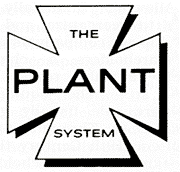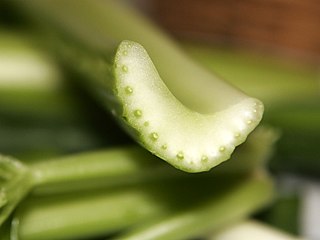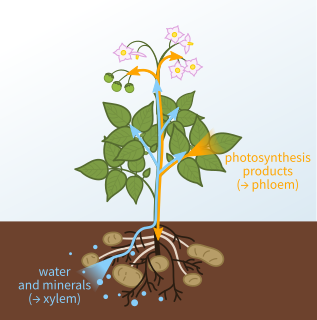
In vascular plants, phloem is the living tissue that transports the soluble organic compounds made during photosynthesis and known as photosynthates, in particular the sugar sucrose, to parts of the plant where needed. This transport process is called translocation. In trees, the phloem is the innermost layer of the bark, hence the name, derived from the Greek word φλοιός (phloios) meaning "bark". The term was introduced by Nägeli in 1858.

Vascular plants, also known as tracheophytes, form a large group of plants that are defined as those land plants that have lignified tissues for conducting water and minerals throughout the plant. They also have a specialized non-lignified tissue to conduct products of photosynthesis. Vascular plants include the clubmosses, horsetails, ferns, gymnosperms and angiosperms. Scientific names for the group include Tracheophyta, Tracheobionta and Equisetopsida sensu lato. The term higher plants should be avoided as a synonym for vascular plants as it is a remnant of the abandoned concept of the great chain of being.

In biology, tissue is a cellular organizational level between cells and a complete organ. A tissue is an ensemble of similar cells and their extracellular matrix from the same origin that together carry out a specific function. Organs are then formed by the functional grouping together of multiple tissues.

The vascular cambium is the main growth layer in the stems and roots of many plants, specifically in dicots such as buttercups and oak trees, and gymnosperms such as pine trees. It produces xylem on the inside and phloem on the outside. In herbaceous plants, it occurs in the vascular bundles which are often arranged like beads on a necklace forming an interrupted ring inside the stem. In woody plants, it forms a continuous ring and grows new wood on the inside.

Thallus, from Latinized Greek θαλλός (thallos), meaning "a green shoot" or "twig", is the undifferentiated vegetative tissue of some organisms in diverse groups such as algae, fungi, some liverworts, lichens, and the Myxogastria. Many of these organisms were previously known as the thallophytes, a polyphyletic group of distantly related organisms. An organism or structure resembling a thallus is called thalloid, thallodal, thalliform, thalline, or thallose.
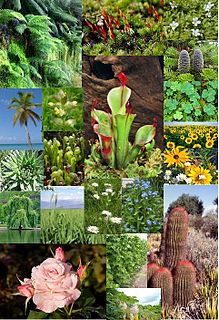
The Embryophyta, or land plants, are the most familiar group of green plants that form vegetation on earth. Embryophyta is a clade within the Phragmoplastophyta, a larger clade that also includes several green algae groups, and within this large clade the embryophytes are sister to the Zygnematophyceae/Mesotaeniaceae and consist of the bryophytes plus the polysporangiophytes. Living embryophytes therefore include hornworts, liverworts, mosses, ferns, lycophytes, gymnosperms and flowering plants. The Embryophyta are informally called land plants because they live primarily in terrestrial habitats, while the related green algae are primarily aquatic. Embryophytes are complex multicellular eukaryotes with specialized reproductive organs. The name derives from their innovative characteristic of nurturing the young embryo sporophyte during the early stages of its multicellular development within the tissues of the parent gametophyte. With very few exceptions, embryophytes obtain their energy by photosynthesis, that is by using the energy of sunlight to synthesize their food from carbon dioxide and water.
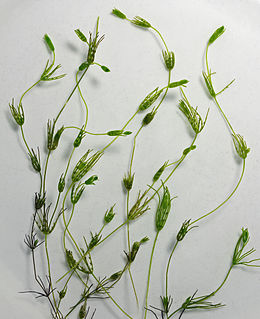
Non-vascular plants are plants without a vascular system consisting of xylem and phloem. Although non-vascular plants lack these particular tissues, many possess simpler tissues that are specialized for internal transport of water.
In a vascular plant, the stele is the central part of the root or stem containing the tissues derived from the procambium. These include vascular tissue, in some cases ground tissue (pith) and a pericycle, which, if present, defines the outermost boundary of the stele. Outside the stele lies the endodermis, which is the innermost cell layer of the cortex.
Lepidodendron — also known as the scale trees — is an extinct genus of primitive, vascular, tree-like plants related to the lycopsids. They were part of the coal forest flora. They sometimes reached heights of over 30 metres (100 ft), and the trunks were often over 1 m (3.3 ft) in diameter. They thrived during the Carboniferous Period before going extinct. Sometimes erroneously called "giant club mosses", the genus was actually more closely related to modern quillworts than to modern club mosses.
Rhizoids are protuberances that extend from the lower epidermal cells of bryophytes and algae. They are similar in structure and function to the root hairs of vascular land plants. Similar structures are formed by some fungi. Rhizoids may be unicellular or multicellular. Roots are multicellular organs composed of multiple tissues that collectively carry out a common function.
Sieve elements are specialized cells that are important for the function of phloem, which is highly organized tissue that transports organic compounds made during photosynthesis. Sieve elements are the major conducting cells in phloem. Conducting cells aid in transport of molecules especially for long-distance signaling. In plant anatomy, there are two main types of sieve elements which are sieve cells and sieve tube members. Sieve cells are specialized cells in the phloem tissue of flowering plants. Companion cells and Sieve cells originate from meristems, which are tissues that actively divide throughout a plant's lifetime. They are similar to the development of xylem, a water conducting cells in plants whose main function is also transportation in the plant vascular system. Sieve elements' major function includes transporting sugars over long distance through plants by acting as a channel. Sieve elements elongate cells containing sieve areas on their walls. Pores on sieve areas allow for cytoplasmic connections to neighboring cells, which allows for the movement of photosynthetic material and other organic molecules necessary for tissue function. Structurally, they are elongated and parallel to the organ or tissue that they are located in. Sieve elements typically lack a nucleus and contain none to a very small number of ribosomes. The two types of sieve elements, sieve tube members and sieve cells, have different structure. Sieve tube members are shorter and wider with greater area for nutrient transport while sieve cells tend to be longer and narrower with smaller area for nutrient transport. Although the function of both of these kinds of sieve elements is the same, sieve cells are found in gymnosperms, non-flowering vascular plants, while sieve tube members are found in angiosperms, flowering vascular plants.
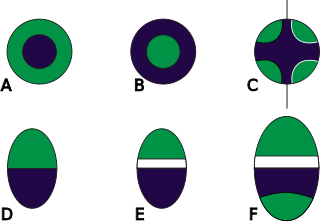
A vascular bundle is a part of the transport system in vascular plants. The transport itself happens in vascular tissue, which exists in two forms: xylem and phloem. Both these tissues are present in a vascular bundle, which in addition will include supporting and protective tissues.

In botany, secondary growth is the growth that results from cell division in the cambia or lateral meristems and that causes the stems and roots to thicken, while primary growth is growth that occurs as a result of cell division at the tips of stems and roots, causing them to elongate, and gives rise to primary tissue. Secondary growth occurs in most seed plants, but monocots usually lack secondary growth. If they do have secondary growth, it differs from the typical pattern of other seed plants.

Plant anatomy or phytotomy is the general term for the study of the internal structure of plants. Originally it included plant morphology, the description of the physical form and external structure of plants, but since the mid-20th century plant anatomy has been considered a separate field referring only to internal plant structure. Plant anatomy is now frequently investigated at the cellular level, and often involves the sectioning of tissues and microscopy.

Polysporangiophytes, also called polysporangiates or formally Polysporangiophyta, are plants in which the spore-bearing generation (sporophyte) has branching stems (axes) that terminate in sporangia. The name literally means many sporangia plant. The clade includes all land plants (embryophytes) except for the bryophytes whose sporophytes are normally unbranched, even if a few exceptional cases occur. While the definition is independent of the presence of vascular tissue, all living polysporangiophytes also have vascular tissue, i.e., are vascular plants or tracheophytes. Fossil polysporangiophytes are known that have no vascular tissue, and so are not tracheophytes.
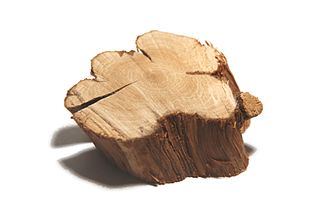
A woody plant is a plant that produces wood as its structural tissue. Woody plants are usually either trees, shrubs, or lianas. These are usually perennial plants whose stems and larger roots are reinforced with wood produced from secondary xylem. The main stem, larger branches, and roots of these plants are usually covered by a layer of bark. Wood is a structural cellular adaptation that allows woody plants to grow from above ground stems year after year, thus making some woody plants the largest and tallest terrestrial plants.

A stem is one of two main structural axes of a vascular plant, the other being the root. The stem is normally divided into nodes and internodes:
Tissue hydration is the process of absorbing and retaining water in biological tissues.
A cambium, in plants, is a tissue layer that provides partially undifferentiated cells for plant growth. It is found in the area between xylem and phloem. It forms parallel rows of cells, which result in secondary tissues.
